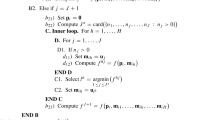Abstract
In this paper, we propose a hierarchical grouping method for non-metric proximity data based on bi-links and ϵ-indiscernibility. It hierarchically forms directional links among objects according their directional proximities. A new cluster can be formed when objects in two clusters are connected with bi-directional links (bi-links). The concept of ϵ-indiscernibility is incorporated into the process of establishing bi-links. This scheme enables users to control the level of asymmetry that can be ignored in merging a pair of objects. Experimental results on the soft drink brand switching data showed that this approach is capable of producing better clusters compared to the straightforward use of bi-links.







Similar content being viewed by others
References
Jain, A.K., Murty, M.N., Flynn, P.J. (1999). Data clustering: a review. ACM Computing Surveys, 31(3), 264–323.
Romesburg, H.C. (1989). Cluster analysis for researchers. Malabar: Krieger.
Saito, T., & Yadohisa, H. (2004). Data analysis of asymmetric structures: Advanced approaches in computational statistics. CRC Press.
Bass, F.M., Pessemier, E.A., Lehmann, D.R. (1972). An experimental study of relationships between attitudes, brand preference, and choice. Behavioral Science, 17(6), 532–541.
Hubert, L. (1973). Min and max hierarchical clustering using asymmetric similarity measures. Psychometrika, 38, 63–72.
Takeuchi, A., Saito, T., Yoshida, H. (2007). Asymmetric agglomerative hierarchical clustering algorithms and their evaluations. Journal of Classification, 24, 123–143.
Hathaway, R.J., & Bezdek, J.C. (1994). NERF c-means: non-Euclidean relational fuzzy clustering. Pattern Recognition, 27(3), 429–437.
Sato-Ilic, M., & Jain, L.C. (2007). Asymmetric clustering based on self-similarity. In Proceedings of the third international conference on intelligent information hiding and multimedia signal processing (pp. 361–364).
Slowinski, R., & Vanderpooten, D. (1997). Similarity relation as a basis for rough approximations. Advances in Machine Intelligence & Soft-Computing, IV, 17–33.
Acknowledgement
This work was supported in part by the grant-in-aid for scientific research (C) #23500179, by the Ministry of Education, Culture, Sports, Science and Technology, Japan.
Author information
Authors and Affiliations
Corresponding author
Rights and permissions
About this article
Cite this article
Hirano, S., Tsumoto, S. Clustering of non-metric proximity data based on bi-links with ϵ-indiscernibility. J Intell Inf Syst 41, 61–71 (2013). https://doi.org/10.1007/s10844-012-0218-3
Received:
Revised:
Accepted:
Published:
Issue Date:
DOI: https://doi.org/10.1007/s10844-012-0218-3




